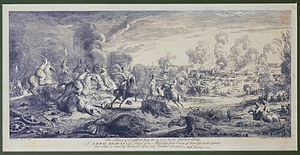Siege of Ochakov (1737)
Appearance
| Siege of Ochakov | |||||||
|---|---|---|---|---|---|---|---|
 | |||||||
| |||||||
| Belligerents | |||||||
|
|
| ||||||
| Commanders and leaders | |||||||
| Hatibzade Yahya Pasha (POW)[2] | Burkhard Christoph von Münnich[2] | ||||||
| Strength | |||||||
| 20,000[2] | 60,000[2][3] | ||||||
| Casualties and losses | |||||||
| 13,000[2][3] | 4,000[4][5][2][3][6] | ||||||
The Siege of Ochakov (1737) was a siege during the Austro-Russian–Turkish War (1735–39) in which the Russian army, led by Burkhard Christoph von Münnich, captured the Ottoman fortress of Ochakov. It took place in 1737.
The Siege

The first Russian attack was repelled with heavy losses, but as a result of Russian mortar fire on the houses within the fortress, fire broke out, and on the second day of the siege the powder magazine within the city blew up, killing an estimated 6,000 defenders. Thereafter the fortress capitulated, and in the ensuing slaughter, in spite of the white flag, all but 3,000 of the garrison were killed. The stench of decaying corpses was such that the Russians had to withdraw 15 miles from the fortress.
Notes
- ^ David R. Stone, A Military History of Russia: From Ivan the Terrible to the War in Chechnya, (Greenwood Publishing Group, 2006), 66.
- ^ a b c d e f Ottoman wars 1700-1870, Virginia H. Aksan, page 107
- ^ a b c Баиов А. К. Русская армия в царствование императрицы Анны Иоанновны. Война России с Турцией в 1736-1739 гг — С. 391.
- ^ Henry C. Lodge. The History of Nations. V. XIV. P. F. Collier. 1913. P. 309
- ^ Керсновский А. А. История Русской армии. 2014. P. 74
- ^ Grinevetsky S., Zonn I., Zhiltsov S., Kosarev A., Kostianoy A. The Black Sea Encyclopedia. Springer. 2014. P. 579
References
- Ottoman wars 1700-1870, Virginia H. Aksan
- Europe and the world, 1650–1830, Jeremy Black
